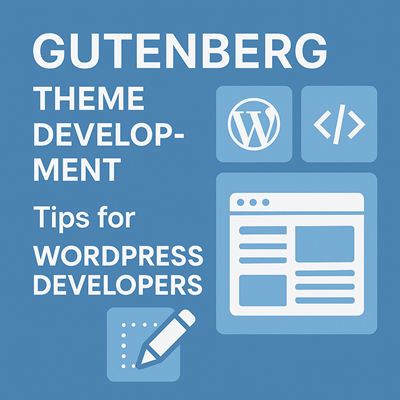
With the rise of Full Site Editing (FSE) and the block editor, Gutenberg has revolutionized how themes are developed in WordPress. It’s no longer just about PHP templates — today’s WordPress developers must embrace JSON, blocks, patterns, and global styles to build fast, modern, and flexible themes.
Whether you’re starting a new theme or adapting a classic one, here are some expert Gutenberg theme development tips to keep you ahead of the curve.
1. Start with a Block-Based Theme Structure
Begin with a solid block-based foundation. Use the official WordPress Theme Handbook or clone a starter theme like emptytheme or blockbase.
Essential folders to include:
-
/block-templates/for templates likeindex.html,single.html -
/block-template-parts/for parts likeheader.html,footer.html -
theme.jsonfor global settings and styles
2. Leverage theme.json for Configuration
The theme.json file is your best friend. It centralizes settings for colors, typography, layout, and more. This not only reduces reliance on custom CSS but also gives users more control in the editor.
Example snippet:
{
“settings”: {
“color”: {
“palette”: [
{ “slug”: “primary”, “color”: “#005f73”, “name”: “Primary” }
]
},
“typography”: {
“fontSizes”: [
{ “slug”: “medium”, “size”: “18px”, “name”: “Medium” }
]
}
}
}
3. Use Block Patterns for Flexibility
Block patterns allow users to insert pre-designed layouts easily. They’re perfect for reusable content sections like hero banners, call-to-actions, or testimonials.
Register patterns in PHP
register_block_pattern_category(‘custom’, [‘label’ => ‘Custom Patterns’]);
register_block_pattern(
‘custom/hero-banner’,
[
‘title’ => __(‘Hero Banner’, ‘textdomain’),
‘content’ => ‘<!– wp:heading {“textAlign”:”center”} –>…<!– /wp:heading –>’,
]
);
4. Avoid Custom CSS Where Possible
Gutenberg provides built-in block controls for margin, padding, font size, color, and more. Encourage clean markup by avoiding custom classes and styles unless necessary. Let users style blocks visually in the editor.
5. Test in the Site Editor
Always test your theme in the Site Editor (Appearance > Editor). Ensure templates load correctly, block styles look as expected, and theme options behave intuitively. Use the editor as your primary development interface — not just the frontend.
6. Ensure Accessibility & Performance
Gutenberg themes must still follow accessibility best practices. Use semantic HTML in templates and patterns. Optimize performance by:
-
Minimizing asset usage
-
Deferring non-critical scripts
-
Using built-in WordPress tools like lazy-loading images
7. Stay Updated with Gutenberg Changes
Gutenberg evolves rapidly. Subscribe to the Make WordPress Core blog or follow the GitHub repository for new releases and feature updates. Keeping your theme compatible with the latest blocks ensures long-term usability.
Final Thoughts
Gutenberg theme development is the future of WordPress. By using theme.json, embracing block-based structures, and leveraging patterns, developers can create intuitive, lightweight, and customizable themes.
Investing time in learning the block editor framework now will give you a major advantage as WordPress continues to evolve toward full site editing.
Want help building your next Gutenberg theme or need a custom WordPress solution? Contact me
